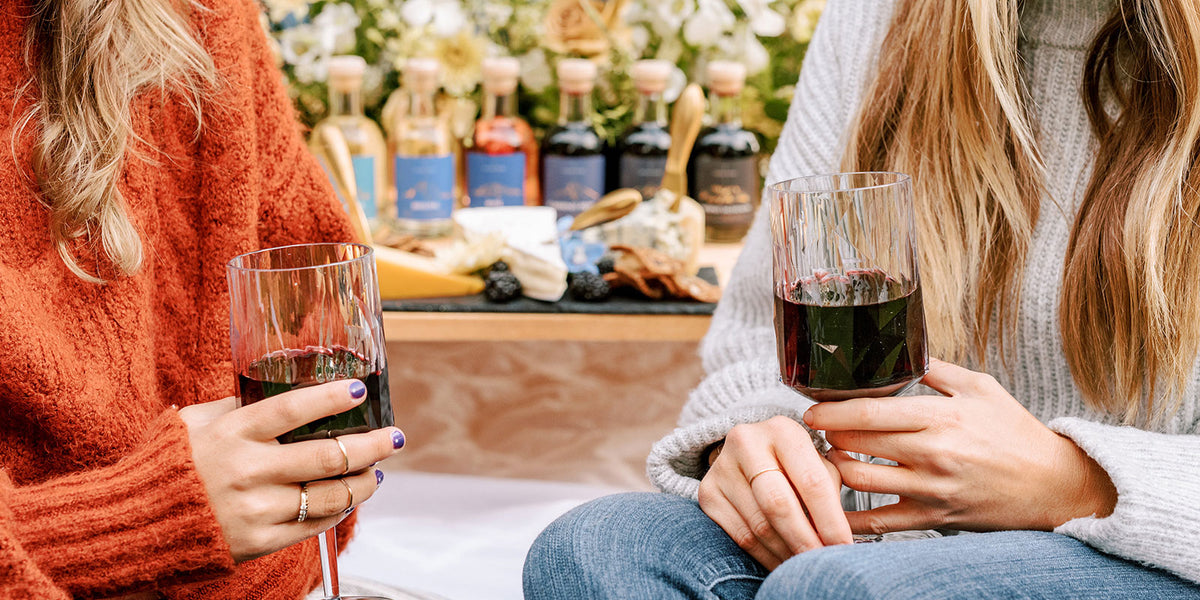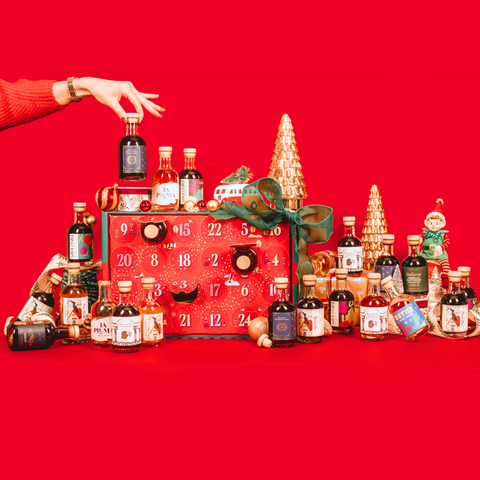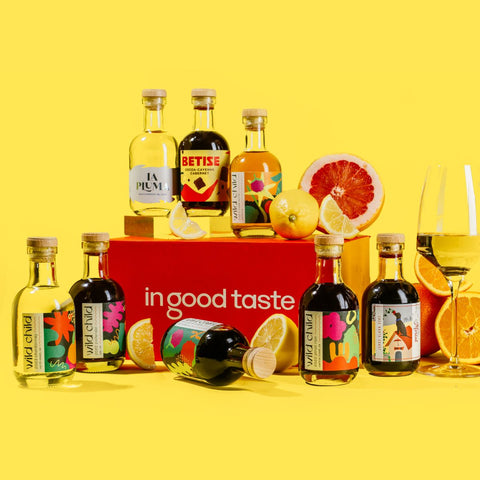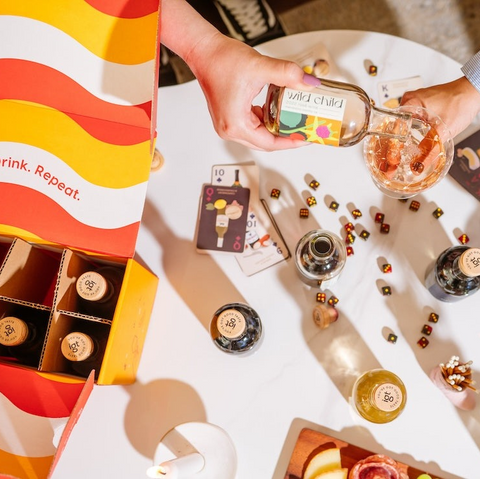All in the residual sugars
If you’re new to the wine world, trying to understand all of the terminology and jargon used by wine lovers can be overwhelming. When you’re trying to catch up, you may be inclined to try every wine on the shelf to figure out what you like. But that would get expensive fast and probably not end in the result you want. So, if you’re not sure whether you like sweet or dry wine, we’ve put together a comprehensive guide so you can find out where you stand. While our focus will be more on introducing you to sweet wine, you’ll gain a better understanding of the difference between sweet and dry as we go along.
What is sweet wine?
If you’ve never had sweet wine, you might be thinking it’s just full of sugar or tastes like dessert. Dessert wines are a part of it, but most sweet wines aren’t overpowering, nor are they sugary like soda. Let’s talk about what really makes wine sweet, the winemaking methods used to produce it, and how some of wine’s sweetness is all in our heads— or at least influenced by our perception.
As you can see on the wine sweetness bottle chart below, both red wines and white wines cover the whole spectrum from bone dry to very sweet, so color isn’t an indicator of sweetness.

The categories indicate how much sugar or sweetness a wine has, with bone dry being essentially zero and very sweet at the maximum level. We pulled some definitions from our wine glossary to clarify:
-
Very Sweet: As sweet as can be, usually highly concentrated and categorized as a dessert wine.
-
Sweet: Scientifically speaking, a wine with over 30 grams of residual sugar per liter is classified as "sweet" (as opposed to "dry" or "off-dry").
-
Semi-Sweet: Contains higher than 3% residual sugar, but not as strong as sweet.
-
Off-Dry: Unlike your average "dry" wine, which is free from sugary flavor, off-dry (aka semi-dry) bottles are just a little sweet.
-
Dry: Indicates lack of sugar or sweetness, which can be very satisfying.
-
Bone Dry: Less than 0.5% residual sugar, a level that can hardly be detected by our taste buds. Extremely dry.
How to Know If a Wine is Sweet by Looking at the Bottle
Let’s say you’re headed to a party, and you asked the host what to bring. “Any bottle of sweet wine,” they said. So, to appear knowledgeable, you said, “Absolutely. I know just the thing!”
While you scour this guide for “just the thing,” we recommend looking closely at the labels on the shelf. There are plenty of very sweet wines in the dessert category, but they’re probably not what they were referring to for dinner, even though they are sweet. So how can you determine which wine is appropriately sweet for the party? Here’s how to decipher the label.

The most reliable indicator of a sweet wine is usually lower alcohol content, aka low ABV percentage. Learning the names of popular sweet wines can also lend you a tip to choosing the right one. Riesling and Moscatoare are the most common sweet choices for white wines, and a Port or Lambrusco will be good picks for red wines. Keep an eye out for words like “doux” and “dolce,” which mean sweet in French, as well as “demi,” which can indicate some sweetness.
Related: Best Wines to Pair with Your Holiday Meal
Difference between Sweetness and Fruitiness
In a typical cocktail, a “fruity” drink is often loaded with added sugar or syrups, rarely containing any fruit at all. But when it comes to wine, sweetness and fruitiness aren’t interchangeable. There are fruity dry wines and “fruitless” sweet wines. This is due to residual sugar, the amount of sugar left in the wine after fermentation. It’s also worth noting that our perception of fruity is often based more on aromatics, whereas sweetness is determined by taste.
Because all grapes are high in sugar content, dry wines will always contain natural sugars. When yeast is added during fermentation, these natural sugars convert into ethanol, better known as alcohol. Most of the grape sugar will turn into alcohol at this point, and winemakers will then add additional sugar to preserve the sweet taste. The yeast, try as it might, is working against too much sugar to convert all of it into alcohol. The result is a wine that’s higher in residual sugar, and a sweet wine is born.
Depending on the grape varietal, acidity, tannins, and other factors, a wine may still embody a wide range of fruit notes and aromatics even if residual sugars are low. That’s why fruitiness and sweetness are both used to describe very different tastes in wine.
Alcohol Content vs. Residual Sugars
If residual sugars are converted into alcohol, thus requiring more sugar to keep the wine sweet, what’s the relationship between alcohol content and residual sugars in making a sweet wine? Ah, the science of sweetness continues.
Okay, investigator, let’s look a little closer at those alcohol labels again. You’re going to be looking at two acronyms. ABV, which is short for Alcohol by Volume, is probably the most familiar one we see. The less obvious acronym (until now) is RS. What does RS stand for? Did you guess Residual Sugar? If so, you're correct!
When you compare these two numbers, you can deduce what’s on the drier or sweeter side. With a high RS and lower ABV, you have a sweet wine. With higher ABV and lower RS, it’s on the drier side. If you prefer to skip the math (and who can blame you?) and just keep an eye out for sweet wine, look for 11% ABV or lower in general. Per usual, there can be exceptions to the rule, but most of the time, a wine with 11% ABV or lower will be on the sweet side of the spectrum.
Methods to Produce Sweet Wines
Winemakers use several methods for producing sweet wines. Here’s a quick roundup.
How are Sweet Wines Made?




Fortification: This method ferments the wine with brandy, creating a fortified wine. The brandy blocks yeast from breaking down so much sugar into alcohol. However, if the winemaker added brandy after the fermenting process, it would return a drier wine.
Noble Rot: An unusual but rewarding method, this method actually comes from a disease called Botrytis. In wet, moist conditions, grapes can be infected with Botrytis when they ripen. If the grapes are moved or exposed to a drier environment, the Botrytis fungus dehydrates the grape and intensifies its natural sweetness. Grapes picked during this time are known to produce concentrated sweet wine.
Ice/Cryoextraction: The process of making ice wine is pretty close to what you would expect. Winemakers take frozen grapes still on the vine and make what results in the concentrated dessert wine we know as ice wine. In some countries, grapes are frozen at 20 degrees Fahrenheit and pressed while still frozen in a method called cryoextraction.
Straw Wine: Making straw wine, also called raisin wine, is essentially the opposite of the process for ice wine. Harvesters spread grape clusters on mats (historically made of straw) in full sun until they dry or raisin. After about a week of sun, they’re ready for the winemakers to ferment, press, and bottle.
Tannins, Acidity, and How They Affect Sweetness
Our taste buds’ perception of sweetness also plays a role in how sweet we consider certain wines. Some people are more sensitive to tannin than others due to the amount of protein in their saliva. If you have more protein in your saliva, tannin has less of an effect on your perception of dryness, so a wine that’s only slightly sweet to others may seem sweeter to you. How do you gauge the amount of protein on your tongue? We’re not sure, but it makes for a fun wine fact!

Acidity also throws off our perception of sweetness because its sourness overpowers the residual sugar. A wine with lower acidity will feature sweeter flavors even if its residual sugars are low, but wines with high acidity will almost always taste drier.
Last but not least, anything that smells sweet will probably taste sweet, too. The same way we get excited for cookies straight out of the oven, a good whiff of a wine’s aromatics will be enough to prime us for the first sip.
Related: Guide to Red Wine
What to Pair with Sweet Wines
Sweet and semi-sweet wines pair well with their opposites, especially smoky or spicy flavors. It’s a good rule of thumb to contrast flavors for a well-rounded taste, so things like charcuterie with hard cheese, nuts, smoked sausage, and other cured meats would go well with sweet wines. They can also go well with sweet and savory plates like honey-glazed ham or pork.
When it comes to dessert wines, we highly suggest going all-in with the decadence! Pair your ice wine or Port with cheesecake, dark chocolate, strawberry cake, or whatever sweet suits your fancy. (There’s a reason they call it “dessert wine”!) We’ve even made a guide to pairing your wine with Halloween candy. Because when dinner’s done and the dessert wine comes out, it’s time to treat yourself!








